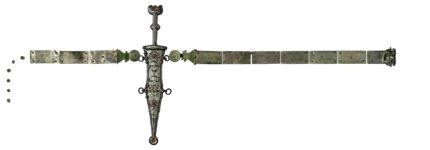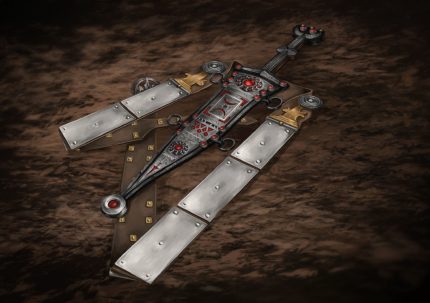A highly decorated Roman silver dagger unearthed last April from a burial ground in Haltern, Germany, has been restored and looks so good you’d think it was a replica. Unearthed complete with its original scabbard and belt, the 1st century pugio is a unique find in the European archaeological record. It was discovered by 19-year-old intern Nico Calmund during a joint excavation done by the Westphalia-Lippe Landscape Association (LWL) and the University of Trier. When his shovel encountered a hard object three feet under the surface, he figured it would be an iron nail, only to find he’d discovered an archaeological sensation.
Its location was incredibly fortuitous. At the time of its burial, the dagger was about 15 inches below the surface. Had it remained that shallow, it could easily have been destroyed by agricultural activity in subsequent centuries. If it had been buried lower or displaced downward, it would have been destroyed or carried away by rainwater runoff. The dagger was preserved in the wash-in horizon, where water infiltration causes matter to accumulate instead of being washed out.
 The fact that it was there at all is puzzling to experts. This was a burial ground for the Roman military camp. The dead were cremated and buried in simple urn graves without goods in a mound. The dagger was found in a trench dug around the hill and backfilled. The only other pugio (no sheath or belt) found at Haltern was unearthed in 1967, but it was in the military camp itself, not the cemetery. The odds of so valuable an object having being lost by accident and left behind at the burial ground are slim, to say the least, so how did it wind up there?
The fact that it was there at all is puzzling to experts. This was a burial ground for the Roman military camp. The dead were cremated and buried in simple urn graves without goods in a mound. The dagger was found in a trench dug around the hill and backfilled. The only other pugio (no sheath or belt) found at Haltern was unearthed in 1967, but it was in the military camp itself, not the cemetery. The odds of so valuable an object having being lost by accident and left behind at the burial ground are slim, to say the least, so how did it wind up there?
![]() The soil where the dagger was found was removed en bloc and transported to the LWL conservation lab for excavation and analysis. Caked in corrosion, the dagger’s details were entirely obscured until X-rays and CT scans revealed that the weapon was still sheathed in its ornately decorated scabbard and the metal belt it hung from 2,000 years ago remained intact.
The soil where the dagger was found was removed en bloc and transported to the LWL conservation lab for excavation and analysis. Caked in corrosion, the dagger’s details were entirely obscured until X-rays and CT scans revealed that the weapon was still sheathed in its ornately decorated scabbard and the metal belt it hung from 2,000 years ago remained intact.
Its narrow blade shape and method of manufacture classify it as a dagger of the Vindonissa type, in use from northern Italy to the North Sea to southern England during the first half of the 1st century. It was manufactured in the Roman province of Noricum (modern-day Austria and Slovenia), the source  of the highest quality steel in the empire and the major purveyor of weapons to the Roman army. The front of the scabbard and the hilt are decorated with finely wrought inlays of silver wire. The thinnest of the silver wire pieces are just .15 millimeters thick. They were placed in herringbone, chevron, diagonal, vertical and horizontal patterns creating dazzling geometric designs, leaves, diamonds, semi-circles, rectangles. Red enamel and red glass circles and triangles dot the sheath and hilt.
of the highest quality steel in the empire and the major purveyor of weapons to the Roman army. The front of the scabbard and the hilt are decorated with finely wrought inlays of silver wire. The thinnest of the silver wire pieces are just .15 millimeters thick. They were placed in herringbone, chevron, diagonal, vertical and horizontal patterns creating dazzling geometric designs, leaves, diamonds, semi-circles, rectangles. Red enamel and red glass circles and triangles dot the sheath and hilt.
As spectacular as it is, this piece was not a decorative accessory. It was a military dagger worn by legionaries, non-commissioned officers or centurions, for close-quarters combat, and there are signs of wear of the blade, areas of silver loss during use. Elements on the knob that would originally have been silver were lost and replaced by brass, and the rings that connected it to the belt are abraded from the leather ties that rubbed against them for years.
Conservators were able to remove the dagger from the sheath and restore both pieces as well as the belt. Even with detailed imaging from the scans, the job took nine months to accomplish.
While conventional X-rays only produce two-dimensional images, computer tomograph[y] depict the objects in many layers that can be viewed individually. “On the basis of the CT images, for example, we were able to see that the handle is made up of numerous individual components made of different materials, which are connected with eight rivet pins. The images also provide information about the maintenance of the exchange work and the condition of the numerous enamel inserts. These Information is of great importance for the subsequent restoration, “said [LWL restorer Eugen] Müsch. In addition, the CT measurement showed that the blade of the dagger consists of different steels that were welded together in the forge.
The belt also consists of numerous elements. The leather was densely covered with bronze or brass plates. To give the impression of expensive silver, the metal plates were coated with tin. The belt has two hooks into which the dagger was hung using leather loops. Parts of the belt leather are still preserved, which even show seams. Flax was used as the yarn.
“Scientific studies and interdisciplinary work are necessary prerequisites for any research nowadays,” explains Prof. Michael Rind, director of LWL archeology for Westphalia. The dagger sheath, for example, consists of a wooden core that was determined as linden wood at the University of Cologne. The exact chemical composition of the metals and the glass inlays was also analyzed.
The dagger, its sheath and belt continue to be studied by experts. The plans is to put them on display in the LWL Roman Museum in Haltern starting March 2022.
This German-language video shows the dagger being scanned with the Helix-CT process and the revelation of what an absolute marvel was hiding underneath the thick encrustations of corrosion material.



